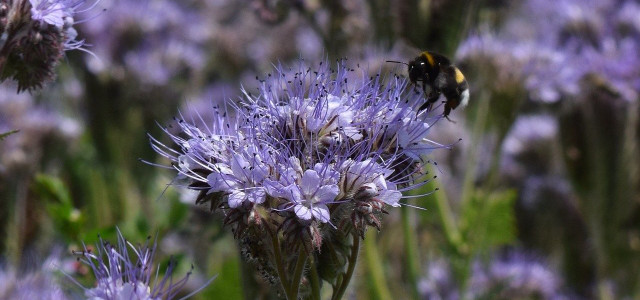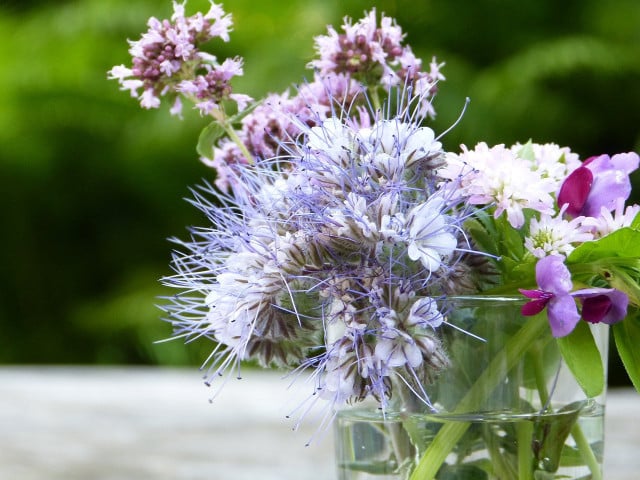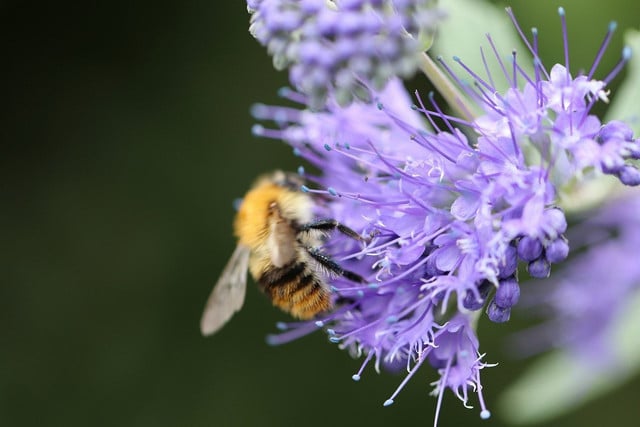
Phacelia is also called “bee friend” because it provides abundant food for bees and other insects. In addition, the plant also looks particularly beautiful. Reason enough to plant it in your garden.
Contents
Phacelia: Versatile bee friend
The Phacelia genus includes about 200 plant species. In this country, the most common is the tansy phacelia, which is also called “bee friend”.
Originally, the plant comes from the west of North America, especially California and Central America, where it grows wild on fields and roadsides. As a wild plant it then came to Europe, where it thrived mainly in regions with lean and dry soils. Today it is cultivated as an ornamental plant in gardens and as a useful plant in agriculture. Phacelia is a very versatile plant. Among other things, it serves as:
- Bee pasture (more on this at the end of the article).
- Green manure plant: Phacelia can improve soil quality. Its root system absorbs soil nutrients well. If phacelia now rots in the soil, it releases the nutrients to the following crop. It also loosens the soil and increases the humus content of the soil, making it more productive.
- Natural weed protection: Phacelia has a root system that penetrates deep into the soil, preventing weeds from growing.
- Forage
- There are annual or perennial species in the Phacelia genus. The popular tansy phacelia here is an annual, upright-growing and herbaceous summer flower that blooms from June to September. It is hardy and undemanding, though not hardy.
Important to know: Tansy phacelia can cause skin rashes if touched.
Sow phacelia

Location
The undemanding bee friend thrives in almost any soil, as long as it is placed in sunny to partial shade. It is important that the soil is rather dry and there is no waterlogging. Phacelia can also be planted in fallow beds or other difficult corners in the garden.
Sowing
Phacelia can be sown in the garden at temperatures from 10 °C. After about 10 days at 15 °C it will start to germinate. You can sow even in August, because the plant germinates and grows so quickly that it will flower even in the same season.
- First, prepare the soil by loosening it a bit.
- Mix the seed with a little sand and spread it wide over the designated area.
- For one square meter you need about two grams of seeds.
- Then rake the seeds into the soil to a depth of two centimeters and moisten the area with a fine spray.
- When the plant wilts, it will continue to self-seed through its seeds in the capsule fruits. To prevent the bee friend from spreading uncontrollably, you can mow it down or bury it before it blooms. Leave the stems and plant parts in the ground. Next spring, the phacelia will bloom again.
Phacelia in the pot
The bee friend also does well in a pot.
Simply fill a container with a mixture of sand and potting soil and sow the seeds directly.
Pour some of the mixture over the seed and water gently.
Care
The bee friend is frugal, so it requires little care. It only needs watering during prolonged dry spells. If the plant is in a pot, the soil may dry out faster and need more frequent watering.
You don’t need to fertilize the Phacelia in the bed, it’s not necessary. However, a little compost now and then can make it bloom more profusely. Potted plants may need a liquid fertilizer every four weeks.
Phacelia as a bee pasture

Phacelia is often found especially in naturalistic gardens. Together with perennials, grasses and other annual summer flowers, it can fill flower beds that not only look beautiful, but are also insect-friendly.
After all, phacelia does not bear the nickname “bee friend” for nothing. Phacelia is a bee pasture. These are plants that offer a particularly large amount of nectar and pollen and thus food for bees and also other insects.
Such bee pastures as phacelia are important to maintain biodiversity. Bees, wild bees and other insects are finding fewer and fewer food options and habitats in the wild. But when gardens are designed to be insect-friendly, such as with the right plants, they become havens for wildlife and insects.









